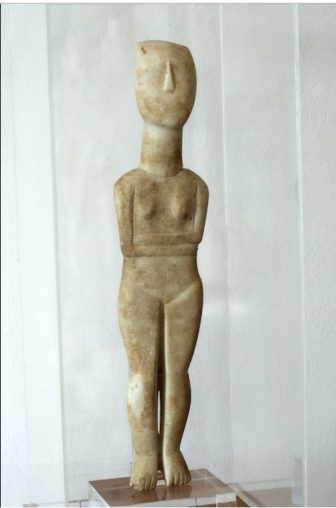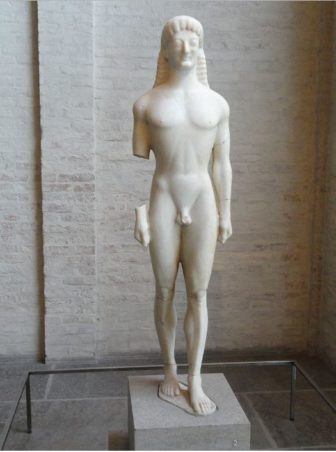ATHENS – Excavations on Despotiko (Δεσποτικό), an uninhabited island in the Aegean archipelago, have revealed details about ancient Greek temples in the late Archaic Age and early Classical Age. The Archaic Age lasted from 776 BCE, year of the first Olympics to 480 BCE, the year of the second Persian invasion.
Based on their finds, they have linked this temple-sanctuary complex to Apollo and possibly Artemis. Researchers found evidence of trade and cultural influence from the Levant and Egypt, but not Athens. In addition, they have found remains of possible workshops and treasuries around the temple-sanctuary complex.
It was during the Archaic Age that the Homeric epics took written form. Greek trade networks and colonies spread across the Mediterranean. The Archaic age provided the cultural, economic, and political base for the Classical Age of Greece.
The current excavations occurred in the Cyclades, the name of the island group of which Despotiko is part. In the middle of these islands, lies Delos, the sacred birthplace of Apollo and Artemis. Southwest from Delos, is Despotiko. Strabo and Pliny mentioned Despotiko. They called it “Prepesinthos.”
Excavations began at this site in the 19th Century. And the current excavations began about a three decades ago. Over multiple digs, researchers have found evidence of 13 buildings. They found Cycladic figurines, marble vessels, obsidian blades, grindstones and spinning whorls.

Zde [CC BY-SA 3.0 (https://creativecommons.org/licenses/by-sa/3.0)
Cycladic Figurine 50 cm: Credit Zde [CC BY-SA 3.0)
The sanctuary temple
Yannos Kourayos, Director of Excavation at Despotiko and part of the Greek Ministry of Culture, is the lead archaeologist on Despotiko. He considers this site to be a sanctuary temple complex based on the significant number of votive materials found. The researchers have found fragments of ceramics with the name “Apollo” written on them. Among the votive offerings, they found a large number which appear “feminine.”
As Delos was sacred to both Apollo and Artemis, Kourayos has theorized that this sanctuary could also be sacred to both.
Kourayos has tried to identify the gender of sculptures and votive offerings. While the ancient Greeks were a patriarchal society, their culture may have been more reluctant to describe gender using a rigid, binary system than contemporary society. For example, while Ares and Aphrodite have a strong gender polarity, Apollo and Artemis do not. Similarly, Dionysius and Apollo appear effeminate at times. Similarly, Artemis hunts and Athena is a goddess of war.
The sanctuary itself dates to the period from 599 to 401 BCE. The temple has a Doric style. In that style, columns end in a simple circular capital. The façade of the temple measured 35 X 15 m (roughly 114 feet, 9.9 inches X 49 feet, 2.6 inches). It had a large stone altar. Multiple buildings surrounded the Temple. Kourayos thinks these buildings played a role in how the temple functioned.
The surrounding buildings
To the south and east of the temple, Kourayos found the remains of the eastern complex. This complex consisted of a large shale-covered courtyard. This courtyard measured 12 X 3 m (39 feet, 4.3 inch X 9 feet, 10 inches). In this area, Kourayos found 15 black oil lamps and many pottery shards.
While most buildings consisted of rectangular rooms, Building Y had a nave-like floor plan, similar to later Christian churches. It measured 7.7 X 6.1 m (roughly 25 feet, 3.1 inches X 20 feet, 0.2 inches). It had a very thick wall, about 1 m (roughly 3 feet, 3.4 inches).
Kourayos has published more on Building A than any other building at this site. This rectangular building had marble walls. The building consisted of a row of five rooms that share a western wall. People built that western wall in two stages. First, people built rooms A1 and A2 on the north end of the building. Then, they built rooms A3 through A5 on the south end. That wall measured 30 meters long (roughly 98 feet, 5.1 inches).
For reasons unknown, the builders of rooms A3 through A5 chose to build a wall with a different thickness than that of rooms A1 and A2. In one stage the wall had a thickness of 0.5 m (roughly. 1 foot,. 7.7 inches). In the other stage, the wall had a thickness of 0.53 m (roughly 1 foot, 8.9 inches).
Rooms A1 and A2 were the same size. Each measured 8 X 8 m (roughly 26 feet, 3 inches X 26 feet, 3 inches). Their marble façade is well-constructed and preserved. These rooms open to the east and share a forecourt. That forecourt measured 3 X 17 m (roughly 9 feet, 10.1 inches X 55 feet, 9.3 inches). Kourayos thinks the forecourt may have had a marble pavement. In the forecourt, they found Corinthian vessels and a stand for basin used in rituals.
The Corinthian ceramics date to the period from 699 BCE to 501 BCE. Many of the found materials had a strong Egyptian influence. From roughly 799 to 701 BCE, Eastern-inspired motifs began to displace geometric motifs in Greek art. Corinth was the center of this style.
Kourayos found an “aryballos” in that forecourt. An aryballos, a small globular flask, was used to contain perfume or oil. In vase paintings, athletes appeared to be using aryballoi. This aryballos was shaped like male genitalia.
Kourayos suspects that room A1 may have functioned as a treasury. Cult objects and figurines may have been kept in this room, along with valued votive offerings. Many of the figurines found appeared to be female, with lots of jewelry, but also daggers and sickles.
Room A2 contained 12 marble pieces in the northeast corner of the room. Some had been recut. Kourayos thinks this room might have functioned as a workshop.
Rooms A3 through A5 differed from A1 and A2. The floor level was about 0.4m (1 foot, 3.7 inches) higher than in the other two rooms. The eastern façade was set back 0.65m (2 feet, 1.6 inches) from that of A1 and A2. All three rooms opened to the east and shared a common corridor with a Doric colonnade. Originally the colonnade had eight columns, but only three remain. The corridor had a paved floor.
Room A3 measured 6m X 7m (roughly 19 feet, 8.2 inches X 22 feet, 11.6 inches). Room A4 measured 5m X 7m (roughly 16 feet, 14.9 inches X 22 feet, 11.6 inches). In the Roman period, inhabitants built over A5 and damaged it.
Along the southern wall, Kourayos found a marble head. Outside the southern wall, he found another head dated to 580 BCE. This head was from a “kouros.” Temples linked to Apollo tend to have these life-size naturalist statues of a nude male youth. Stylistically, kouroi show a strong Egyptian influence.
Both the northern and southern walls continued beyond the eastern façade of Rooms A1 to A5. These extensions of the wall may have marked the limits of the sanctuary space.
While Kourayos found lots of Corinthian pottery, his team found almost no Athenian pottery. At the end of the archaic period, a great deal of hostility existed between Athens and Corinth. This would suggest that cultural, trade and diplomatic networks could have linked Despotiko and Corinth, but not Despotiko and Athens.
The Wild Hunt is not responsible for links to external content.
To join a conversation on this post:
Visit our The Wild Hunt subreddit! Point your favorite browser to https://www.reddit.com/r/The_Wild_Hunt_News/, then click “JOIN”. Make sure to click the bell, too, to be notified of new articles posted to our subreddit.
